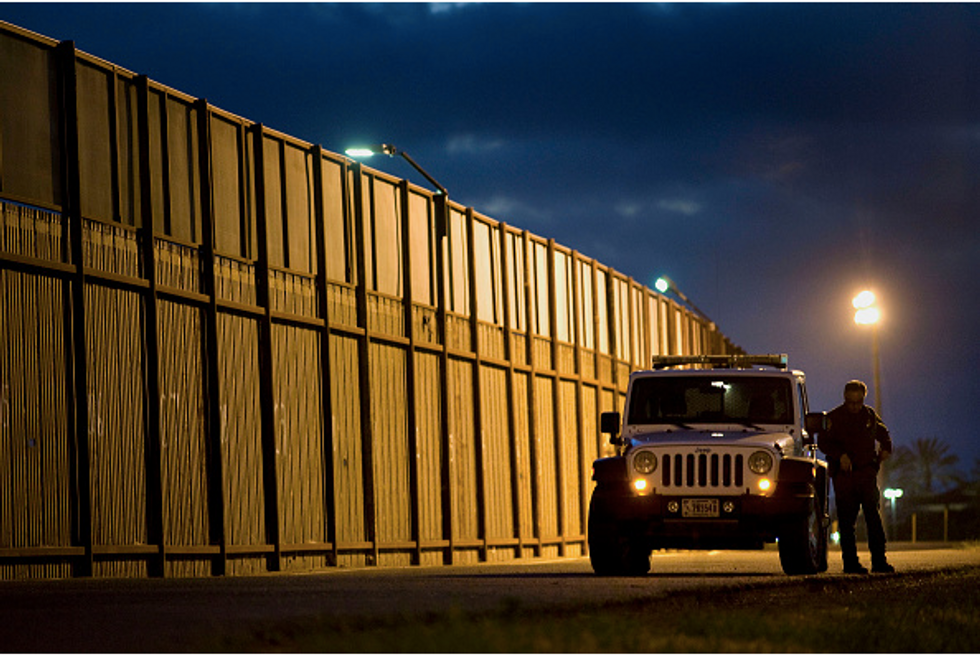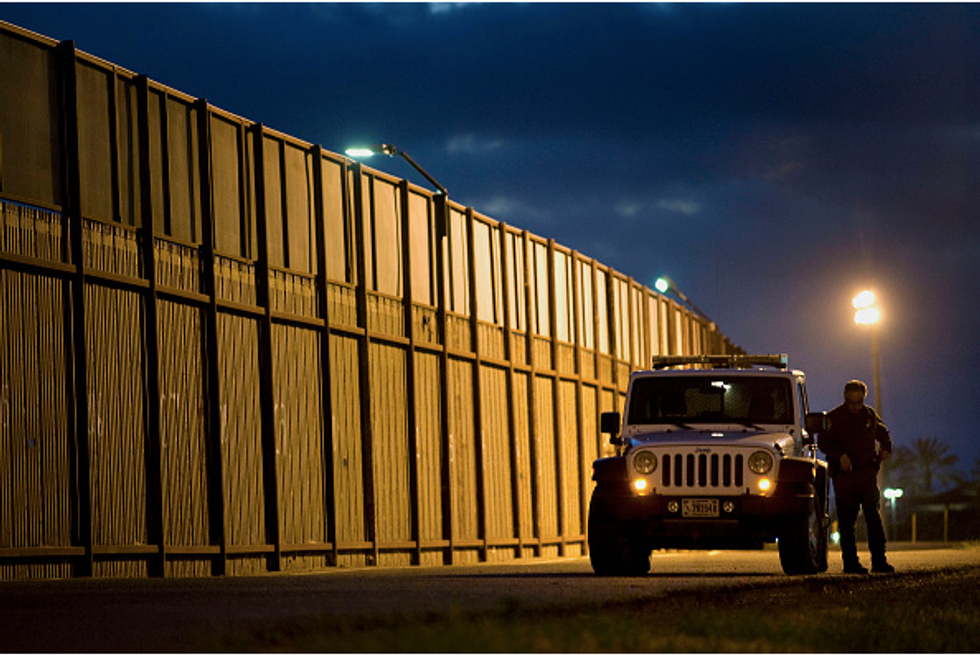
A U.S. Border Patrol agents stands outside his vehicle next to the U.S.-Mexico border fence in San Diego, California, U.S., on Thursday, Feb. 26, 2015. Photographer: David Maung/Bloomberg via Getty Images

SAN DIEGO (AP) — A sign that greets motorists entering the U.S. at the nation's busiest border crossing shows a silhouette of a man, woman and pigtailed girl running for their lives under the word "Caution."
It was erected 25 years ago, when hordes of immigrants regularly stormed the border in "banzai runs" from Mexico, startling drivers along California's Interstate 5.
The sign looks strangely out of place today.

A 14-mile (22.4-kilometer) fence and tougher U.S. enforcement have dramatically reduced the illegal flow of immigrants across this stretch of border, while the legal movement of Mexicans and Americans back and forth across the international boundary for business or pleasure has been getting faster and more efficient.
On balance, Republican presidential candidate Donald Trump's portrait of a border out of control doesn't square with what people see every day in San Diego and, on the Mexican side, Tijuana, which together make up the biggest metropolitan area along the 1,954-mile (3,126.4-kilometer) divide.
Serious problems persist. For one thing, San Diego's San Ysidro border crossing has become a favored route for methamphetamine smugglers. Still, sneaking across this stretch of the border has become far more difficult, even for the most fit and fearless.
At the same time, an expanded San Ysidro crossing has slashed delays for Mexican visitors who legally work, shop and play in San Diego, while Tijuana's flourishing restaurant and arts scene draws American foodies. A few miles away, construction crews are extending Tijuana's airport across the border by building both a pedestrian bridge and a terminal in San Diego.
"It's nothing like it used to be," said Roman Real, a resident of central Mexico who returned to the Tijuana-San Diego area last week after a 10-year absence to introduce his three children to San Diego tourist attractions.
Real waited just 10 minutes in a car to cross at San Ysidro — the site of one of every 10 international arrivals in the United States. It was a dramatic improvement from the "catastrophe" he remembered.
"The border has its vices," he said while waiting on a bench for his wife at a San Diego outlet mall that opened in 2001 near San Ysidro and counts Polo Ralph Lauren, Brooks Brothers and Armani among its stores. But "if you're a tourist, things look good. Very normal."
In the early 1990s, the barren mesas and shrub-covered canyons that extend east of the Pacific Ocean were the most popular routes for immigrants entering the United States illegally. Some Mexicans played soccer on U.S. soil, waiting for nightfall to make a run past Border Patrol agents positioned a half-mile back.
"We waited for them to come at us. You just tried to get in front of them and catch as many as you could," said Dave Brown, who was a Border Patrol agent in San Diego for 30 years before retiring in 2006.
The U.S. launched Operation Gatekeeper in 1994, a crackdown that brought additional agents to San Diego. Arizona soon overtook San Diego as the nation's busiest corridor for illegal crossings. South Texas now holds that dubious distinction.
In San Diego, an 18-foot (540-centimeter) mesh fence extending 14 miles (22.4 kilometers) from the Pacific Ocean was completed in 2009, with razor wire topping about half of it. A treacherously winding dirt road traversing an area known as Smugglers Gulch was flattened out at a cost of $57 million, making it easier to patrol.
Arrests in the Border Patrol's San Diego sector last year totaled 29,911 — down about 95 percent from a peak of 565,581 in 1992.
People pay smugglers about $10,000 to guide them through the mountains east of San Diego, despite the risk of being kidnapped for ransom on the way. Only the most motivated are willing to try.
"See how desperate I am?" Jose Mendoza, 45, said at a Tijuana shelter, pointing to cuts on his belly from when he got tangled in a wire border fence and decided to turn around. "It's very hard."
For those entering legally, crossing has gotten easier since September, when the number of vehicle lanes at San Ysidro was increased from 17 to 25, most with two inspection booths each instead of one. The crossing received about 77,000 motorists and pedestrians a day last year, citizens and non-citizens alike.
On the other side of the border, the daylight shootouts and beheadings that terrified Tijuana a few years ago have become extremely rare, though homicides during the first half of this year are up 56 percent from the same period in 2012.
On weekends, former San Diego newspaper reporter Derrik Chinn takes Americans on walking tours of Tijuana, showing them something more than the usual trinkets, cheap margaritas and rides on zonkeys (a cross between a zebra and a donkey.) His itineraries include restaurants, a culinary school, wrestling matches, open-air markets and craft breweries.
The tours have given people "a whole new take on a city they had brushed off as a dusty little tourist trap," he said.